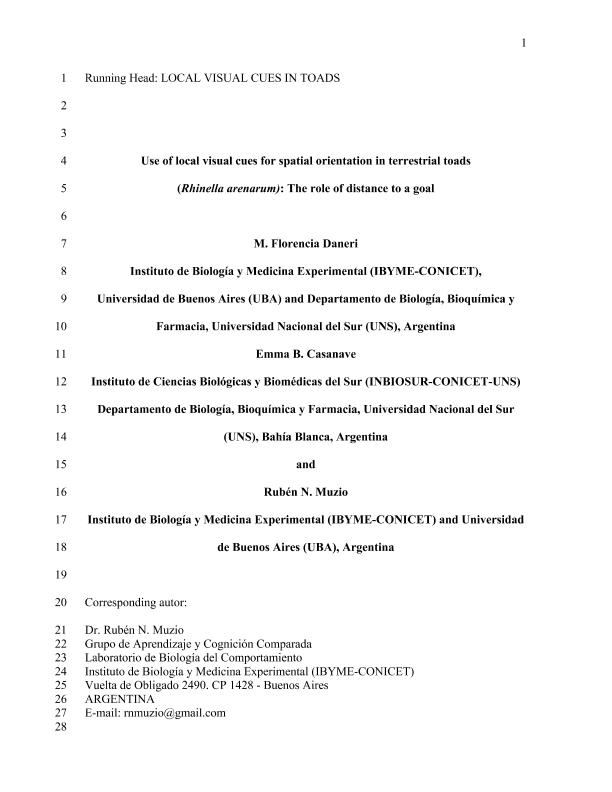Mostrar el registro sencillo del ítem
dc.contributor.author
Daneri, Maria Florencia

dc.contributor.author
Casanave, Emma Beatriz

dc.contributor.author
Muzio, Ruben Nestor

dc.date.available
2016-07-04T16:55:42Z
dc.date.issued
2015-06
dc.identifier.citation
Daneri, Maria Florencia; Casanave, Emma Beatriz; Muzio, Ruben Nestor; Use of local visual cues for spatial orientation in terrestrial toads (Rhinella arenarum): The role of distance to a goal; American Psychological Association; Journal of Comparative Psychology; 129; 3; 6-2015; 247-255
dc.identifier.issn
0735-7036
dc.identifier.uri
http://hdl.handle.net/11336/6327
dc.description.abstract
The use of environmental visual cues for navigation is an ability present in many groups of animals. The effect of spatial proximity between a visual cue and a goal on reorientation in an environment has been studied in several vertebrate groups, but never previously in amphibians. In this study we tested the use of local visual cues (beacons) to orient in an open field in the terrestrial toad Rhinella arenarum. Experiment 1 showed that animals could orient in space using two cues located near the rewarded container. Experiment 2 used only one cue placed at different distances to the goal and revealed that learning speed was affected by the proximity to the goal (the closer the cue was to the goal, the faster toads learned its location). Experiment 3 showed that the position of a cue results in a different predictive value. Animals preferred cues located closer to the goal more than those located farther away as a reference for orientation. Present results revealed, for the first time, that (i) toads can learn to orient in an open space using visual cues, and that (ii) the effect of spatial proximity between a cue and a goal, a learning phenomenon previously observed in other groups of animals such as mammals, birds, fish and invertebrates, also affects orientation in amphibians. Thus, our results suggest that toads are able to employ spatial strategies that closely parallel to those described in other vertebrate groups, supporting an early evolutionary origin for these spatial orientation skills.
dc.format
application/pdf
dc.language.iso
eng
dc.publisher
American Psychological Association

dc.rights
info:eu-repo/semantics/openAccess
dc.rights.uri
https://creativecommons.org/licenses/by-nc-sa/2.5/ar/
dc.subject
Spatial Orientation Skills
dc.subject
Visual Cues
dc.subject.classification
Otras Ciencias Biológicas

dc.subject.classification
Ciencias Biológicas

dc.subject.classification
CIENCIAS NATURALES Y EXACTAS

dc.title
Use of local visual cues for spatial orientation in terrestrial toads (Rhinella arenarum): The role of distance to a goal
dc.type
info:eu-repo/semantics/article
dc.type
info:ar-repo/semantics/artículo
dc.type
info:eu-repo/semantics/publishedVersion
dc.date.updated
2016-05-10T14:35:35Z
dc.journal.volume
129
dc.journal.number
3
dc.journal.pagination
247-255
dc.journal.pais
Estados Unidos

dc.journal.ciudad
Washington
dc.description.fil
Fil: Daneri, Maria Florencia. Consejo Nacional de Investigaciones Científicas y Técnicas. Instituto de Biología y Medicina Experimental (i); Argentina. Universidad Nacional del Sur; Argentina
dc.description.fil
Fil: Casanave, Emma Beatriz. Consejo Nacional de Investigaciones Cientificas y Tecnicas. Centro Cientifico Tecnol.conicet - Bahia Blanca. Instituto de Ciencias Biologicas y Biomedicas del Sur; Argentina. Universidad Nacional del Sur; Argentina
dc.description.fil
Fil: Muzio, Ruben Nestor. Consejo Nacional de Investigaciones Científicas y Técnicas. Instituto de Biología y Medicina Experimental (i); Argentina. Universidad de Buenos Aires; Argentina
dc.journal.title
Journal of Comparative Psychology

dc.relation.alternativeid
info:eu-repo/semantics/altIdentifier/doi/10.1037/a0039461
dc.relation.alternativeid
info:eu-repo/semantics/altIdentifier/doi/http://dx.doi.org/10.1037/a0039461
dc.relation.alternativeid
info:eu-repo/semantics/altIdentifier/pmid/26147701
dc.relation.alternativeid
info:eu-repo/semantics/altIdentifier/url/http://psycnet.apa.org/journals/com/129/3/247/
Archivos asociados
